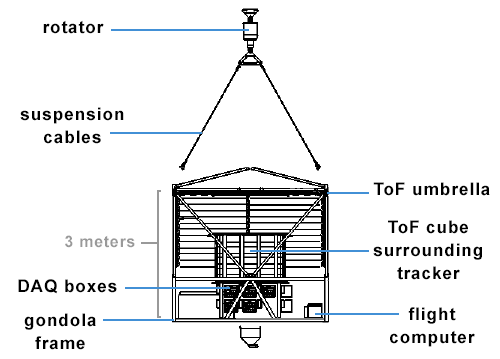 GAPS
Searching for dark matter with cosmic-ray antimatter
GAPS
Searching for dark matter with cosmic-ray antimatter
 GAPS
Searching for dark matter with cosmic-ray antimatter
GAPS
Searching for dark matter with cosmic-ray antimatter
GAPS (General AntiParticle Spectrometer) is an Antarctic balloon mission designed to search for low-energy (< 0.25 GeV/n) cosmic-ray antinuclei in the austral summer of 2025. GAPS is designed to precisely measure the flux of low-energy cosmic-ray antideuterons, antiprotons, and antihelium. To date, there has not been an unambiguous observation of cosmic-ray antideuterons or antihelium, and observation by GAPS of even a single antideuteron could tell us about the particle nature of dark matter.
GAPS uses an exotic atom technique to identify antiparticles with a high degree of certainty. Low-energy antiparticles will be slowed in the material of the GAPS tracker and eventually captured by a nucleus, resulting in an exotic atom in an excited state. This exotic atom will then quickly decay, producing X-rays at uniquely defined energies and a correlated pion and proton signature from the subsequent nuclear annihilation.
GAPS relies on a time-of-flight (ToF) system, which tags candidate events for the detector to save and makes a precise velocity measurement, and a tracker system, which serves as the target and tracker for the initial cosmic-ray particle and its annihilation products. The detection concept has been validated in an accelerator beam test at KEK, Japan in 2005, as well as in a balloon-borne prototype experiment (pGAPS) with a ToF system and 6 Si(Li) detectors, successfully flown from the JAXA/ISAS balloon base in Taiki in June 2012. In November of 2024, the GAPS instrument was assembled and prepared for its first flight at the Long Duration Balloon facility at McMurdo Station, Antarctica. The launch will occur during the austral summer of 2025.
 Cartoon illustrating some of the theoretical considerations involved in determining the antideuteron flux at Earth due to dark matter. Dark matter particles annihilate (or decay) into Standard Model particles, of which some may form an antideuteron. Antideuterons then propagate through the galaxy, heliosphere, and upper atmosphere to GAPS.
Cartoon illustrating some of the theoretical considerations involved in determining the antideuteron flux at Earth due to dark matter. Dark matter particles annihilate (or decay) into Standard Model particles, of which some may form an antideuteron. Antideuterons then propagate through the galaxy, heliosphere, and upper atmosphere to GAPS.
Dark matter accounts for approximately 84% of the matter in the universe, but its exact nature remains unknown. Present observations indicate that dark matter is inconsistent with any standard model particle, and only interacts with standard model particles very weakly. Determining the fundamental properties of dark matter remains a major goal in physics and astronomy.
Many hypothetical dark matter particles can annihilate or decay into Standard Model particles. Dark matter may then be observed indirectly through the detection of these particles, in excess of their conventional backgrounds. Cosmic-ray antimatter provides one of the cleanest channels of indirect dark matter detection since their natural astrophysical fluxes are low (relative to protons, for example). In particular, the flux of low-energy antideuterons due to dark matter is expected to be many orders of magnitude above the astrophysical background. A precise measurement of the cosmic-ray antiproton spectrum in an unprecedented low-energy range will also be sensitive to certain dark matter signals, and will reduce systematic uncertainties in the antideuteron search.
 Notional schematic of the GAPS instrument, with thermal system and solar panels omitted.
Notional schematic of the GAPS instrument, with thermal system and solar panels omitted.
GAPS is designed to achieve high acceptance of low-energy cosmic-ray antiparticles while maintaining strong background suppression, subject to mass, size, power, and temperature contraints. Unlike antimatter search experiments that use magnetic spectrometers, GAPS uses an exotic atom technique to identify antiparticles based on X-rays and pions/protons. Additionally, ToF measurements of particle velocity and dE/dx, as well as the stopping depth of the particle in the tracker, ensure low ambiguity in particle identification.
The GAPS instrument consists of the ToF, tracker, flight computer, and thermal system. Additionally, a gondola provides the instrument with mechanical support, solar panels provide power, and custom electronics are used throughout. The ToF is made of two layers, composed of 160 plastic scintillator paddles, and uses silicon photomultipliers (SiPMs) to detect the photons produced by passing particles. The tracker is made of 1,440 lithium-drifted silicon (Si(Li)) detectors, arranged in 10 layers of 12 by 12 rows.
